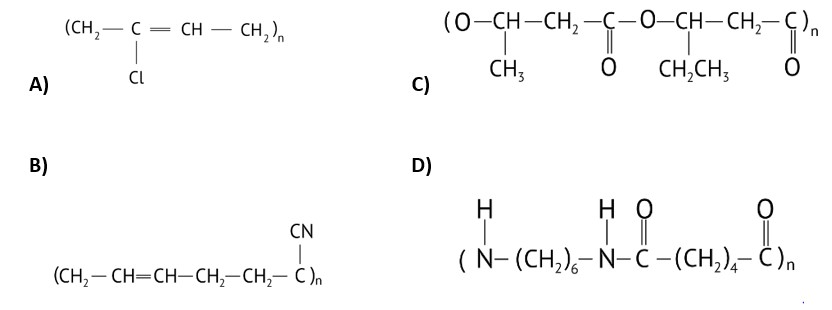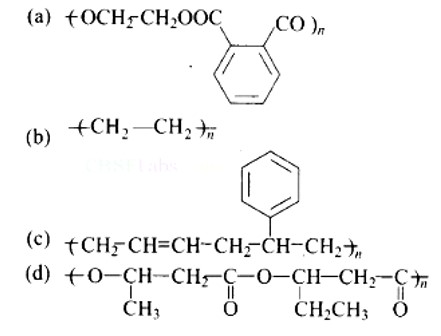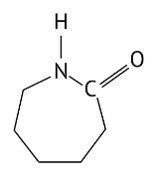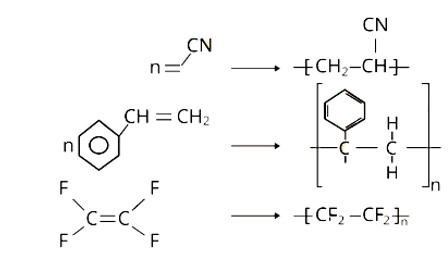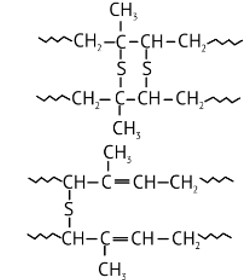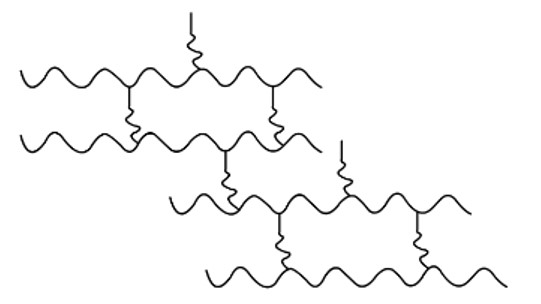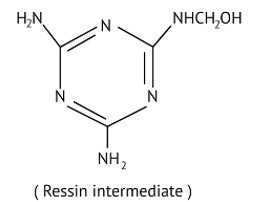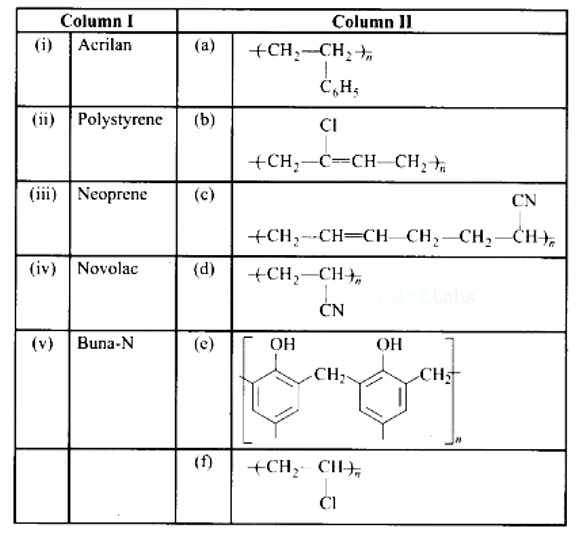
- Polymers Long Answer type Questions
- Polymers Multiple Choice Questions
- Polymers Short Answer Type Questions
- Polymers Matching Type Questions
- Polymers Assertion and Reason Type Questions
- 111111111
Polymers Long Answer type Questions
| 1. Synthetic polymers do not degrade in the environment for a long time. How can biodegradable synthetic polymers be made. Differentiate between biopolymers and biodegradable polymers and give examples of each type. |
| Ans: 1.Poly-hydroxybutyrate-co-β-hydroxyvalerate (PHBV) It's made by copolymerization 3-hydroxybutanoic acid and 3-hydroxypentanoic acid. PHBV is used in specialty packaging, orthopaedic devices, and controlled drug release. In the environment, PHBV is degraded by bacteria. Nylon 2-Nylon 6: It is a biodegradable alternating polyamide copolymer of glycine and amino caproic acid. Biopolymers are natural polymers found in plants and animals such as protein, fat, cellulose, and so on. Biodegradable polymers are polymers that contain functional groups that are similar to those found in biopolymers. They are not resistant to the processes of environmental degradation. |
| 2. Differentiate between rubbers and plastics on the basis of intermolecular forces |
| Ans: In rubber, the polymer chain are held together by weakest force of attraction. While, in plastic, the strong intermolecular force of attraction is present between elastomers and fibres. In rubber, a few crosslinks are introduced between the chain, while plastics are linear or slightly branched molecules which gets soft on heating and hard on cooling. |
Commonly asked questions
Synthetic polymers do not degrade in the environment for a long time. How can biodegradable synthetic polymers be made. Differentiate between biopolymers and biodegradable polymers and give examples of each type.
This is a Long Answer Type Questions as classified in NCERT Exemplar
1.Poly-hydroxybutyrate-co-β-hydroxyvalerate (PHBV)
It's made by copolymerization 3-hydroxybutanoic acid and 3-hydroxypentanoic acid. PHBV is used in specialty packaging, orthopaedic devices, and controlled drug release. In the environment, PHBV is degraded by bacteria.
Nylon 2-Nylon 6: It is a biodegradable alternating polyamide copolymer of glycine and amino caproic acid.
Biopolymers are natural polymers found in plants and animals such as protein, fat, cellulose, and so on.
Biodegradable polymers are polymers that contain functional groups that are similar to those found in biopolymers. They are not resistant to the processes of environmental degradation.
Differentiate between rubbers and plastics on the basis of intermolecular forces
This is a Long Answer Type Questions as classified in NCERT Exemplar
In rubber, the polymer chain are held together by the weakest force of attraction. While, in plastic, the strong intermolecular force of attraction is present between elastomers and fibres.
In rubber, a few crosslinks are introduced between the chain, while plastics are linear or slightly branched molecules which gets soft on heating and hard on cooling.
Phenol and formaldehyde undergo condensation to give a polymer (A) which on heating with formaldehyde gives a thermosetting polymer (B). Name the polymers. Write the reactions involved in the formation of (A). What is the structural difference between two polymers?
This is a Long Answer Type Questions as classified in NCERT Exemplar
The oldest synthetic polymers are phenol-formaldehyde polymers. These are made by combining phenol and formaldehyde in the presence of either an acid or a base catalyst. The reaction begins with the formation of o-and/or p hydroxymethyl phenol derivatives, which then react with phenol to form compounds with shaving rings connected by –CH2 groups. The first product could be a linear product, such as Novolac.
When heated with formaldehyde, Novolac crosslinks to form Bakelite, an infusible solid mass.
It is used to make combs, phonograph records, electrical switches, and utensil handles.
The polymer A is Novolac and polymer B is Bakelite.
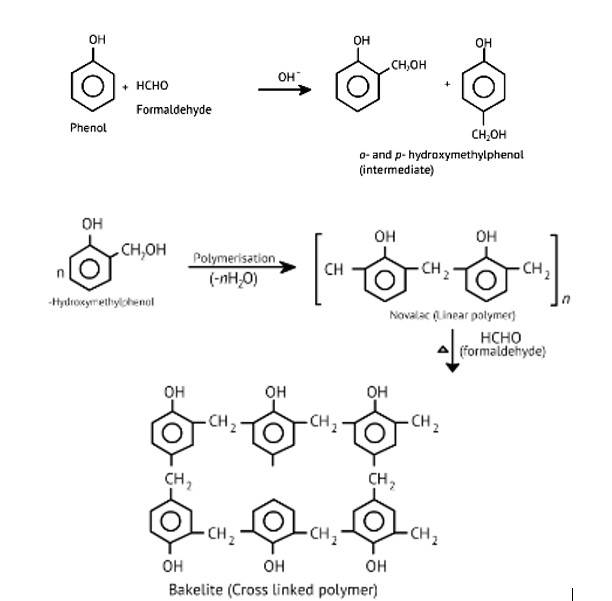
Low density polythene and high density polythene, both are polymers of ethene but there is marked difference in their properties. Explain.
This is a Long Answer Type Questions as classified in NCERT Exemplar
Ans:


Which of the following polymers soften on heating and harden on cooling? What are the polymers with this property collectively called? What are the structural similarities between such polymers? Bakelite, urea-formaldehyde resin, polythene, polyvinyl, polystyrene.
This is a Long Answer Type Questions as classified in NCERT Exemplar
Thermoplastic polymer
Thermoplastic polymers are linear or slight branched-chain polymers. In this type of polymer, the strong intermolecular force of attraction is present between elastomers and fibers. This type of polymer softens on heating and hardens on cooling. For example, polythene, polystyrene and polyvinyl.
Thermosetting polymer
Thermosetting polymers are cross-linked polymers. These polymers on heating undergo cross-linking in molds. They become infusible on heating so, cannot be reused again. For example, Bakelite and urea-formaldehyde resins.
CNG is an important transportation fuel. When 100g CNG is mixed with 208g oxygen in vechicles, it leads to the formation of CO2 and H2O and produces large quantity of heat during this combustion, then the amount of carbon dioxide produced in germs is ______.
(nearest integer)
[Assume CNG to be methane]
Mole
Hence mole of CO2 formed =
And wt of CO2 in gm =
In a solid AB, A atoms are in ccp arrangement and B atoms occupy all octahedral sites. If two atoms from the opposite face are removed, then the resultant stoichiometry of the compound is AxBy. The value of x is ___________(nearest integer)
After removal A = 4 -
After removal B = 4 – 1 = 4 (only two atoms are removed)
Final formula of the compound = A3B4
Amongst SF4, XeF4, CF4 and H2O, the number of species with two lone pairs of electrons is___________.
Water has only two lone pair and XeF4 has two lone pair electron in opposite plane of the central atom.
A fish swimming in water body when taken out from the water body is covered with a film of water of weight 36g. When it is subjected to cooking at 100°C, then the internal energy for vaporization in kJ mol1 is_____________. (nearest integer)
[Assume steam to be an ideal gas. Given for water at 373K and 1 bar is 41.1 kJ mol1; R = 8.31 JK1mol1]
Vapourisation of
Mole of H2O =
The osmotic pressure exerted by a solution prepared by dissolving 2.0g of protein of molar mass 60 kg mol1 in 200 mL of water at 27°C is_______Pa. (nearest integer)
(Use R = 0.083 L bar mol1 K1)
= 415 Pa
40% of HI undergoes decomposition to H2 and I2 at 300K. for this decomposition reaction at one atmosphere pressure is_____________J mol1 (nearest integer)
(Use R = 8.31 JK1 mol1; log 2= 0.3010, In 10 = 2.3, log 3 = 0.477)
t = eq 1 - a
=
Cu(s) + Sn2+(0.001M) Cu2+ (0.01M) + Sn(s)
The Gibbs free energy change for the above reaction at 298 K is x × 101 KJmol1. The value of x is __________. (nearest integer)
[Given : 0.34V; = 0.14V; F = 96500 Cmol1]
cell reaction is ;
Nearest integer = 983
Catalyst A reduces the activation energy for a reaction by 10 kJ mol1 at 300K. The ratio of rate constants, The value of x is_________. (nearest integer)
[Assume that the pre-exponential factor is same in both the cases. Given R = 8.31 JK1 mol1]
Reaction of [Co(H2O)6]2+ with excess ammonia and in the presence of oxygen results into a diamagnetic product. Number of electrons present in t2g-orbitals of the product is_________.
(form of paired electron)
No. of electron in t2g = 6
The moles of methane required to produce 81 g of water after complete combustion is________× 102 mol. (nearest integer)
2 moles of water produced by 1 mole of methane
Or 36 gm of water produced by 1 mole of CH4
81 gm of water produced = = 2.25 mole of CH4
Mole of CH4 required = 225 × 10-2
the nearest integer = 225
Polymers Multiple Choice Questions
| 1. Which of the following polymers of glucose are stored by animals? (A) Cellulose (B) Amylose (C) Amylopectin (D) Glycogen |
| Ans: Option (D) Explanation: Glycogen is a branched polymer of glucose found in the liver, muscles, and brain of animals. |
| 2. Which of the following is not a semisynthetic polymer? (A) Cis-polyisoprene (B) Cellulose nitrate (C) Cellulose acetate (D) Vulcanised rubber |
| Ans: Option (A) Explanation: Semi-synthetic polymers are obtained from natural polymers. Cellulose derivatives like cellulose nitrate, cellulose acetate rubber are examples of semi-synthetic polymers. Cis-polyisoprene is not a semi-synthetic polymer while other examples are semi-synthetic polymer. |
Commonly asked questions
Which of the following polymers of glucose are stored by animals?
(A) Cellulose
(B) Amylose
(C) Amylopectin
(D) Glycogen
This is a multiple choice answer as classified in NCERT Exemplar
Option (D)
Explanation: Glycogen is a branched polymer of glucose found in the liver, muscles, and brain of animals.
Which of the following is not a semisynthetic polymer?
(A) Cis-polyisoprene
(B) Cellulose nitrate
(C) Cellulose acetate
(D) Vulcanised rubber
This is a multiple choice answer as classified in NCERT Exemplar
Option (A)
Explanation: Semi-synthetic polymers are obtained from natural polymers. Cellulose derivatives like cellulose nitrate, cellulose acetate rubber are examples of semi-synthetic polymers.
Cis-polyisoprene is not a semi-synthetic polymer while other examples are semi-synthetic polymer.
The commercial name of polyacrylonitrile is ______________.
(A) Dacron
(B) Orlon (acrilan)
(C) PVC
(D) Bakelite
This is a multiple choice answer as classified in NCERT Exemplar
Option (B)
Explanation: Polyacrylonitrile is used as a wool substitute in the manufacture of commercial fibers such as orlon or acrilan.
Which of the following polymers is biodegradable?
This is a multiple choice answer as classified in NCERT Exemplar
Option (C)
Explanation: PHBV (Poly beta-hydroxybutyrate co-beta-hydroxy valerate) is a biodegradable polymer. It undergoes bacterial degradation in the environment. The structure is shown as,
In which of the following polymers ethylene glycol is one of the monomer units?
This is a multiple choice answer as classified in NCERT Exemplar
Option (A)
Explanation: Dacron or Terylene is formed by the condensation polymerization of ethylene glycol and phthalic acid with the elimination of water molecules. The structure of Terylene is,
Which of the following statements is not true about low density polythene?
(A) Tough
(B) Hard
(C) Poor conductor of electricity
(D) Highly branched structure
This is a multiple choice answer as classified in NCERT Exemplar
Option (B)
Explanation: Low-density polythene is obtained from the polymerization of ethane under high pressure and temperature. Low-density polyethylene is tough, a poor conductor of electricity and has a highly branched structure.
Low-density polythene is not hard because branched structure prevents stacking and thus, reduces the intermolecular force of attraction.
So, option (B) is correct.
Which of the following polymer can be formed by using the following monomer unit?
(A) Nylon-6,6
(B) Nylon 2–nylon 6
(C) Melamine polymer
(D) Nylon-6
This is a multiple choice answer as classified in NCERT Exemplar
Option (D)
Explanation: The given structure is caprolactam. Nylon-6 is prepared from the monomer caprolactam. It is obtained by heating caprolactam with water at a high temperature.
Note : In the following questions two or more options may be correct.
Which of the following polymers need at least one di ene monomer for their preparation?
(A) Dacron
(B) Buna-S
(C) Neoprene
(D) Novolac
This is a multiple choice answer as classified in NCERT Exemplar
Option (B) and (C)
Explanation: Buna-S and neoprene are the polymers that needs at least one diene monomeric unit. Buna- S is a polymer formed from the polymerization of 1,3-butadiene and styrene. While, Neoprene is formed by the polymerisation of chloroprene.
Which of the following are characteristics of thermosetting polymers?
(A) Heavily branched cross linked polymers.
(B) Linear slightly branched long chain molecules
(C) Become infusible on moulding so cannot be reused.
(D) Soften on heating and hardened on cooling, can be reused.
This is a multiple choice answer as classified in NCERT Exemplar
Option (A) and (C)
Explanation: Thermosetting polymers are cross linked polymers. These polymers on heating undergo cross linking in moulds. They become infusible on heating so cannot be reused again.
Which of the following polymers are thermoplastic?
(A) Teflon
(B) Natural rubber
(C) Neoprene
(D) Polystyrene
This is a multiple choice answer as classified in NCERT Exemplar
Option (A) and (D)
Explanation: Thermoplastic polymers are linear or slight branched-chain polymers. This type of polymer softens on heating and hardens on cooling. For example, Teflon and polystyrene are thermoplastic polymers.
So, options (A) and (D) are correct.
Which of the following polymers are used as fiber?
(A) Polytetrafluoroethane
(B) Polychloroprene
(C) Nylon
(D) Terylene
This is a multiple choice answer as classified in NCERT Exemplar
Option (C) and (D)
Explanation: Fibers are thread-forming solids. They possess high tensile strength and high modulus. They have strong intermolecular forces of attraction like hydrogen bonding. Nylon and Terylene are used as fibers.
Which of the following are addition polymers?
(A) Nylon
(B) Melamine formaldehyde resin
(C) Orlon
(D) Polystyrene
This is a multiple choice answer as classified in NCERT Exemplar
Option (A) and (D)
Explanation: The formation of addition polymers is accomplished through the repeated addition of monomer molecules with double or triple bonds, such as polythene from ethene and polypropene from propene. Homopolymers are addition polymers formed by the polymerisation of a single monomeric species.
Which of the following polymers are condensation polymers?
(A) Bakelite
(B) Teflon
(C) Butyl rubber
(D) Melamine formaldehyde resin
This is a multiple choice answer as classified in NCERT Exemplar
Option (A) and (D)
Explanation: Condensation polymers are formed by the addition of more than one monomeric unit. Bakelite and Melamine formaldehyde resin are condensation polymers. Bakelite is a polymer formed from phenol and formaldehyde. Melamine formaldehyde resin is a polymer formed from melamine and formaldehyde.
Which of the following monomers form biodegradable polymers?
(A) 3-hydroxybutanoic acid+ 3-hydroxypentanoic acid
(B) Glycine+Aminocaproic acid
(C) Ethylene glycol + Phtahlic acid
(D) Caprolactum
This is a multiple choice answer as classified in NCERT Exemplar
Option (A) and (B)
Explanation: The polymers that are not harmful to the environment are biodegradable polymers. PHBV (Poly beta-hydroxybutyrate co-beta-hydroxy valerate) is a biodegradable polymer. It undergoes bacterial degradation in the environment. PHBV is obtained by the polymerization of 3-hydroxybutyric acid and 3-hydroxypentanoic acid.
Nylon-2, Nylon-6 polymers are also biodegradable. It is obtained by the polymerization of glycine and aminocaproic acid.
Which of the following are examples of synthetic rubber?
(A) Polychloroprene
(B) Polyacrylonitrile
(C) Buna-N
(D) Cis-polyisoprene
This is a multiple choice answer as classified in NCERT Exemplar
Option (A) and (C)
Explanation: Synthetic rubbers are either homopolymers or copolymers of 1,3-butadiene or its derivatives with another unsaturated monomer. Polychloroprene or neoprene and Buna-N are examples of synthetic rubber.
Which of the following polymers can have strong intermolecular forces?
(A) Nylon
(B) Polystyrene
(C) Rubber
(D) Polyesters
This is a multiple choice answer as classified in NCERT Exemplar
Option (A) and (D)
Explanation: Polyamides: These polymers with amide linkages are important examples of synthetic fibers and are known as nylons.
Polyesters: These are the polycondensation products of dicarboxylic acids and diols.
Dacron or terylene is the most well-known example of a polyester.
Which of the following polymers have vinylic monomer units?
(A) Acrilan
(B) Polystyrene
(C) Nylon
(D) Teflon
This is a multiple choice answer as classified in NCERT Exemplar
Option (A), (B) and (D)
Explanation: Polyacrylonitrile is formed by the addition polymerisation of acrylonitrile in the presence of a peroxide catalyst. Polyacrylonitrile is used as a wool substitute in the manufacture of commercial fibers such as orlon or acrilan.
Polystyrene has the monomer unit styrene.
Teflon is made by heating tetrafluoroethene at high pressures with a free radical or persulphate catalyst.
Vulcanisation makes rubber ____________
(A) More elastic
(B) Soluble in inorganic solvent
(C) Crystalline
(D) More stiff
This is a multiple choice answer as classified in NCERT Exemplar
Option (A) and (D)
Explanation: Vulcanisation is a process used to improve the physical properties of natural rubber. This method involves heating a mixture of raw rubber, sulphur, and an appropriate additive to temperatures ranging from 373 K to 415 K. Sulphur forms cross links at the reactive sites of double bonds during vulcanisation, stiffening the rubber.
Polymers Short Answer Type Questions
| 1. A natural linear polymer of 2-methyl-1, 3-butadiene becomes hard on treatment with sulphur between 373 to 415K and —S—S— bonds are formed between chains. Write the structure of the product of this treatment? |
| Ans: While manufacturing tyre rubber, 5 % sulfur is used as a crosslinking agent. A natural linear polymer of 2-methyl-1, 3-butadiene becomes hard on treatment with sulfur and forms vulcanised rubber. The structure of the product formed is, |
| 2. Identify the type of polymer. —A—A—A—A—A—A— |
| Ans: Addition polymers formed by the polymerization of a single monomeric species are known as homopolymers. The above-given polymer is a homopolymer. |
Commonly asked questions
A natural linear polymer of 2-methyl-1, 3-butadiene becomes hard on treatment with sulphur between 373 to 415K and —S—S— bonds are formed between chains. Write the structure of the product of this treatment?
This is a short answer type question as classified in NCERT Exemplar
While manufacturing tyre rubber, 5 % sulfur is used as a crosslinking agent. A natural linear polymer of 2-methyl-1, 3-butadiene becomes hard on treatment with sulfur and forms vulcanised rubber. The structure of the product formed is,
Identify the type of polymer.
—A—A—A—A—A—A—
This is a short answer type question as classified in NCERT Exemplar
Addition polymers formed by the polymerization of a single monomeric species are known as homopolymers. The above-given polymer is a homopolymer.
Identify the type of polymer.
—A—B—B—A—A—A—B—A—
This is a short answer type question as classified in NCERT Exemplar
Addition polymers formed by the polymerization from two different monomers are co-polymers. The above-given polymer is a co-polymer. For example Buna-N, Buna-S.
Out of chain growth polymerization and step growth polymerisation, in which type will you place the following.
(−A−)m+(−A−)n→(−A−A−)m+n
This is a short answer type question as classified in NCERT Exemplar
This is a type of chain-growth polymerization. The molecules of the same monomer or different monomer are added together to form this type of polymer.
Identify the type of polymer given in the following figure.
This is a short answer type question as classified in NCERT Exemplar
The polymer shown above is cross-linked or network polymer. They are formed from bi or tri-functional monomers that contain strong covalent bond between polymer chains.
Identify the polymer given below :
This is a short answer type question as classified in NCERT Exemplar
The cis-polyisoprene molecule is made up of several chains that are held together by weak van there Waals interactions and has a coiled structure. Thus, it can be stretched like a spring and exhibits elastic properties.
Why are rubbers called elastomers?
This is a short answer type question as classified in NCERT Exemplar
Rubber is a natural polymer. It is also known as an elastomer due to its elastic properties. It is manufactured from rubber latex.
Can an enzyme be called a polymer?
This is a short answer type question as classified in NCERT Exemplar
Enzymes are biocatalysts that are present in the body. They are basically proteins, and they are also considered as polymers.
Can nucleic acids, proteins and starch be considered as step growth polymers?
This is a short answer type question as classified in NCERT Exemplar
Yes, nucleic acids, proteins, and starch can be considered step growth polymers because this type of polymerization involves a condensation reaction between two monomers. Loss of simple molecules such as water, alcohol results in this type of polymerization and it results in the formation of high molecular mass polymers.
How is the following resin intermediate prepared and which polymer is formed by this monomer unit?
This is a short answer type question as classified in NCERT Exemplar
Melamine formaldehyde polymer is formed by the condensation polymerization of melamine and formaldehyde. This is resin intermediate.
To have practical applications why are cross-links required in rubber?
This is a short answer type question as classified in NCERT Exemplar
A vulcanisation process is used to improve the physical properties of natural rubber. This process consists of heating a mixture of raw rubber with sulphur and an appropriate additive at a temperature range between 373 K to 415 k. Sulphur forms cross links at the reactive sites of double bonds during vulcanization, stiffening the rubber.
Why does cis-polyisoprene possess elastic property?
This is a short answer type question as classified in NCERT Exemplar
Cis-polyisoprene has a coiled structure which consists of various chains held together by weak Van there Waals force of attraction. It can be stretched like a spring and thus, has elastic properties.
What is the structural difference between HDP and LDP? How does the structure account for different behaviour and nature, hence the use of a polymer?
This is a short answer type question as classified in NCERT Exemplar
LDP: The polymerization of ethene under high pressure and temperature in the presence of peroxide catalyst gives low-density polythene. It is obtained through free radical addition and has a high branched structure. It is chemically inert and is a poor conductor of electricity. It is used for manufacturing toys, bottles.
HDP: When addition polymerization of ethene takes place in a hydrocarbon solvent in the presence of a catalyst such as triethylaluminium and Ziegler-Natta catalyst at high temperature and pressure then high-density polythene is formed. It consists of linear molecules. It is also chemically inert. It is used for manufacturing buckets, dustbins.
What is the role of benzoyl peroxide in addition polymerisation of alkenes? Explain its mode of action with the help of an example.
This is a short answer type question as classified in NCERT Exemplar
Free radicals are generated from benzoyl peroxide. Alkanes, dienes are polymerized in the presence of free radical inhibitors like benzoyl peroxide, acetyl peroxide. For example, benzoyl peroxide inhibitor is used for the polymerization of ethene to polythene. First, phenyl peroxide radicals are formed which are added to the double bond of ethene generating a new and larger free radical.
Which factor imparts crystalline nature to a polymer like nylon?
This is a short answer type question as classified in NCERT Exemplar
Polymers that possess amide linkage are termed as nylon. Fibers have a strong intermolecular force of attraction like hydrogen bonding. It leads to the close packing of the structure which imparts the crystalline nature.
Name the polymers used in laminated sheets and give the name of monomeric units involved in its formation.
This is a short answer type question as classified in NCERT Exemplar
Urea-formaldehyde resin is used in laminated sheets. The monomer involved in the formation of urea formaldehyde resin is urea and formaldehyde.
Which type of biomolecules have some structural similarity with synthetic polyamides? What is this similarity?
This is a short answer type question as classified in NCERT Exemplar
Proteins have some similar structural similarities with synthetic polyamides. Proteins and polyamides both contain amide linkage.
Why should the monomers used in addition to polymerization through free radical pathway be very pure?
This is a short answer type question as classified in NCERT Exemplar
Monomers used in addition to polymerization through free radical pathway should be very pure because even the traces of impurities acts like inhibitors. It leads to the formation of polymers with a shorter chain lengths.
Polymers Matching Type Questions
| Note : Match the items of Column I with the items in Column II. 1. Match the polymer of column I with the correct monomer of column II.
|
||||||||||||
| Ans: (i) → (e) (ii) → (c) (iii) → (a) (iv) → (b) (v) → (d) |
| 2. Match the polymers given in Column I with their chemical names given in Column II.
|
||||||||||||
| Ans: (i) → (c) (ii) → (a) (iii) → (b) (iv) → (e) (v) → (d) |
Commonly asked questions
Note : Match the items of Column I with the items in Column II.
Match the polymer of column I with the correct monomer of column II.
|
Column I |
Column II |
|
i. High density polythene |
a. Isoprene |
|
ii. Neoprene |
b. Tetrafluoroethene |
|
iii. Natural Rubber |
c. Chloroprene |
|
iv. Teflon |
d. Acrylonitrile |
|
v. Acrilan |
e. Ethene |
This is a matching answer type question as classified in NCERT Exemplar
(i) → (e) (ii) → (c) (iii) → (a) (iv) → (b) (v) → (d)
Match the polymers given in Column I with their chemical names given in Column II.
|
Column I |
Column II |
|
i. Nylon-6 |
a. Polyvinyl chloride |
|
ii. PVC |
b. Polyacrylonitrile |
|
iii. Acrilan |
c. Polycaprolactum |
|
iv. Natural Rubber |
d. Low density polythene |
|
v. LDP |
e. cis-polyisoprene |
This is a matching answer type question as classified in NCERT Exemplar
(i) → (c) (ii) → (a) (iii) → (b) (iv) → (e) (v) → (d)
Match the polymers given in Column I with their commercial names given in Column II.
|
Column I |
Column II |
|
i. Polyester of glycol and phthalic acid |
a. Novolac |
|
ii. Copolymer of 1,3-butadiene and styrene |
b. Glyptal |
|
iii. Phenol and formaldehyde resin |
c. Buna-S |
|
iv. Polyester of glycol and terephthalic acid |
d. Buna-N |
|
v. Copolymer of 1,3-butadiene and acrylonitrile |
e. Dacron |
This is a matching answer type question as classified in NCERT Exemplar
(i) → (b) (ii) → (c) (iii) → (a) (iv) → (e) (v) → (d)
Match the polymers given in Column I with their main applications given in Column II
|
Column I |
Column II |
|
i. Bakelite |
a. Unbreakable crockery |
|
ii. LDP |
b. Non-stick cookwares |
|
iii. Melamine-formaldehyde resin |
c. Packaging material for shock absorbance |
|
iv. Nylon-6 |
d. Electrical switches |
|
v. Poly tetrafluoro ethane |
e. Squeeze bottles |
|
vi. Polystyrene |
f. Tyre, cords |
This is a matching answer type question as classified in NCERT Exemplar
(i) → (d) (ii) → (e) (iii) → (a) (iv) → (f) (v) → (b) (vi) → (c)
Match the polymers given in Column I with the preferred mode of polymerisation followed by their monomers.
|
Column I |
Column II |
|
i. Nylon-6,6 |
a. Free radical polymerisation |
|
ii. PVC |
b. Ziegler-Natta polymerisation or coordination polymerisation |
|
iii. HDP |
c. Anionic polymerisation |
|
d. Condensation polymerisation |
This is a matching answer type question as classified in NCERT Exemplar
(i) → (d) (ii) → (a) (iii) → (b)
Match the polymers given in Column I with the type of linkage present in them given in Column II.
|
Column I |
Column II |
|
i. Terylene |
a. Glycosidic linkage |
|
ii. Nylon |
b. Ester linkage |
|
iii. Cellulose |
c. Phosphodiester linkage |
|
iv. Protein |
d. Amide linkage |
|
v. RNA |
This is a matching answer type question as classified in NCERT Exemplar
(i) → (b) (ii) → (d) (iii) → (a) (iv) → (d) (v) → (c)
Match materials given in Column I with the polymers given in Column II.
|
Column I |
Column II |
|
i. Natural rubber latex |
a. Nylon |
|
ii. Wood laminates |
b. Neoprene |
|
iii. Ropes and fibers |
c. Dacron |
|
iv. Polyester fabric |
d. Melamine-formaldehyde resins |
|
v. Synthetic rubber |
e. Urea-formaldehyde resins |
|
vi. Unbreakable crockery |
f. cis-polyisoprene |
This is a matching answer type question as classified in NCERT Exemplar
(i) → (f) (ii) → (e) (iii) → (a) (iv) → (c) (v) → (b) (vi) → (d)
Match the polymers given in Column I with their repeating units given in Column II.
This is a matching answer type question as classified in NCERT Exemplar
(i) → (d) (ii) → (a) (iii) → (b) (iv) → (e) (v) → (c)
Polymers Assertion and Reason Type Questions
| Note : In the following questions a statement of assertion followed by a statement of reason is given. Choose the correct answer out of the following choices.
1. Assertion : Rayon is a semi synthetic polymer and is taken as a better choice than cotton fabric. Reason : Mechanical and aesthetic properties of cellulose can be improved by acetylation. (i) Assertion and reason both are correct statement but reason does not explain assertion. (ii) Assertion and reason both are correct statements and reason explains the assertion. (iii) Both assertion and reason are wrong statement. (iv) Assertion is correct statement and reason is wrong statement. (v) Assertion is wrong statement and reason is correct statement. |
| Ans: (ii) Assertion and reason both are correct statements and reason explains the assertion. Explanation: Rayon is a semi synthetic polymer. It is preferred over cotton fabric because its properties are improved by acetylation. |
| 2. Assertion : Most of the Synthetic polymers are not biodegradable. Reason : Polymerisation process induces toxic character in organic molecules.
(i) Assertion and reason both are correct statement but reason does not explain assertion. (ii) Assertion and reason both are correct statements and reason explains the assertion. (iii) Both assertion and reason are wrong statement. (iv) Assertion is correct statement and reason is wrong statement. (v) Assertion is wrong statement and reason is correct statement. |
| Ans: (iv) Assertion is correct statement and reason is wrong statement. (v) Assertion is wrong statement and reason is correct statement. Explanation: Most of the Synthetic polymers are not biodegradable. A large number of the polymers are resistant to the degradation process of the environment and therefore, are responsible for the accumlation of polymeric solid waste material. |
Commonly asked questions
Note : In the following questions a statement of assertion followed by a statement of reason is given.
Choose the correct answer out of the following choices.
Assertion : Rayon is a semi synthetic polymer and is taken as a better choice than cotton fabric.
Reason : Mechanical and aesthetic properties of cellulose can be improved by acetylation.
(i) Assertion and reason both are correct statement but reason does not explain assertion.
(ii) Assertion and reason both are correct statements and reason explains the assertion.
(iii) Both assertion and reason are wrong statement.
(iv) Assertion is correct statement and reason is wrong statement. (v) Assertion is wrong statement and reason is correct statement.
This is a assertion and reason answer type question as classified in NCERT Exemplar
(ii) Assertion and reason both are correct statements and reason explains the assertion.
Explanation: Rayon is a semi synthetic polymer. It is preferred over cotton fabric because its properties are improved by acetylation.
Assertion : Most of the Synthetic polymers are not biodegradable.
Reason : Polymerisation process induces toxic character in organic molecules.
(i) Assertion and reason both are correct statement but reason does not explain assertion.
(ii) Assertion and reason both are correct statements and reason explains the assertion.
(iii) Both assertion and reason are wrong statement.
(iv) Assertion is correct statement and reason is wrong statement. (v) Assertion is wrong statement and reason is correct statement.
This is a assertion and reason answer type question as classified in NCERT Exemplar
(iv) Assertion is correct statement and reason is wrong statement. (v) Assertion is wrong statement and reason is correct statement.
Explanation: Most of the Synthetic polymers are not biodegradable. A large number of the polymers are resistant to the degradation process of the environment and therefore, are responsible for the accumlation of polymeric solid waste material.
Assertion : Olefinic monomers undergo addition polymerisation.
Reason : Polymerisation of vinylchloride is initiated by peroxides/ persulphates.
(i) Assertion and reason both are correct statement but reason does not explain assertion.
(ii) Assertion and reason both are correct statements and reason explains the assertion.
(iii) Both assertion and reason are wrong statement.
(iv) Assertion is correct statement and reason is wrong statement. (v) Assertion is wrong statement and reason is correct statement.
This is a assertion and reason answer type question as classified in NCERT Exemplar
(i) Assertion and reason both are correct statement but reason does not explain assertion.
Explanation: Olefinic monomers undergo addition polymerisation. The molecules of the same monomer or different monomer are added together to form this type of polymer. This mode of polymerisation leads to an increase in chain length.
Assertion : Polyamides are best used as fibres because of high tensile strength.
Reason : Strong intermolecular forces (like hydrogen bonding within polyamides) lead to close packing of chains and increase the crystalline character, hence, provide high tensile strength to polymers.
(i) Assertion and reason both are correct statement but reason does not explain assertion.
(ii) Assertion and reason both are correct statements and reason explains the assertion.
(iii) Both assertion and reason are wrong statement.
(iv) Assertion is correct statement and reason is wrong statement. (v) Assertion is wrong statement and reason is correct statement.
This is a assertion and reason answer type question as classified in NCERT Exemplar
(ii) Assertion and reason both are correct statements and reason explains the assertion.
Explanation: Polyamides are best used as fibres because of high tensile strength. They have the strongest intermolecular forces of attraction like hydrogen bonding. It lead to close packing of chains and increase the crystalline character.
Assertion : For making rubber synthetically, isoprene molecules are polymerised.
Reason : Neoprene (a polymer of chloroprene) is a synthetic rubber.
(i) Assertion and reason both are correct statement but reason does not explain assertion.
(ii) Assertion and reason both are correct statements and reason explains the assertion.
(iii) Both assertion and reason are wrong statement.
(iv) Assertion is correct statement and reason is wrong statement. (v) Assertion is wrong statement and reason is correct statement.
This is a assertion and reason answer type question as classified in NCERT Exemplar
(v) Assertion is wrong statement and reason is correct statement.
Explanation: Synthetic rubber is a type of rubber polymer that are capable of getting stretched to twice of its length. They are homopolymers of either 1,3-butadiene derivatives or copolymers of butadiene. Polychloroprene or neoprene is a type of synthetic rubber.
Assertion : Network polymers are thermosetting.
Reason : Network polymers have high molecular mass.
(i) Assertion and reason both are correct statement but reason does not explain assertion.
(ii) Assertion and reason both are correct statements and reason explains the assertion.
(iii) Both assertion and reason are wrong statement.
(iv) Assertion is correct statement and reason is wrong statement. (v) Assertion is wrong statement and reason is correct statement.
This is a assertion and reason answer type question as classified in NCERT Exemplar
(i) Assertion and reason both are correct statements but reason does not explain assertion.
Explanation: Thermosetting polymers are cross linked polymers. They are highly branched polymers with high molecular masses. These polymers on heating undergo cross linking in moulds. They become infusible on heating.
Assertion : Polytetrafluoroethene is used in making non-stick cookwares.
Reason : Fluorine has highest electronegativity.
(i) Assertion and reason both are correct statement but reason does not explain assertion.
(ii) Assertion and reason both are correct statements and reason explains the assertion.
(iii) Both assertion and reason are wrong statement.
(iv) Assertion is correct statement and reason is wrong statement. (v) Assertion is wrong statement and reason is correct statement.
This is a assertion and reason answer type question as classified in NCERT Exemplar
(iv) Assertion is correct statement and reason is wrong statement. (v) Assertion is wrong statement and reason is correct statement.
Explanation: Most of the Synthetic polymers are not biodegradable. A large number of the polymers are resistant to the degradation process of the environment and therefore, are responsible for the accumlation of polymeric solid waste material.
111111111
111111111111111111111111111111111111111111111111111
Chemistry NCERT Exemplar Solutions Class 12th Chapter Fifteen Exam



